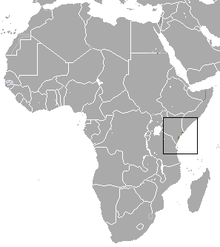Rhynchocyon chrysopygus
| Golden-rumped elephant shrew | |
|---|---|
 |
|
| Scientific classification | |
| Kingdom: | Animalia |
| Phylum: | Chordata |
| Class: | Mammalia |
| Order: | Macroscelidea |
| Family: | Macroscelididae |
| Genus: | Rhynchocyon |
| Species: | R. chrysopygus |
| Binomial name | |
|
Rhynchocyon chrysopygus Günther, 1881 |
|
 |
|
| Range | |
The golden-rumped elephant shrew (Rhynchocyon chrysopygus) is a small African mammal. It is the largest species of the elephant shrew family. It is classified as endangered.
The golden-rumped elephant shrew is found in the northern coastal areas in and around Arabuko Sokoke National Park Mombasa in Kenya. Its name derives from the conspicuous golden fur on its hindquarters, distinctive golden coloration on its rump, and grizzled gold forehead contrasting with its dark reddish-brown color. The golden-rumped elephant shrew has long muscular rear legs and shorter, less developed forelegs. Like other elephant-shrews, this species has a long and flexible snout. This is where its Genus gets its name. Its tail is largely black except for the last third, which is white with a black tip. On juveniles, the fur shows vestigial traces of a checkerboard pattern seen on giant elephant shrews like the checkered elephant shrew.
The golden-rumped elephant shrews are monogamous and territorial behavior is seen in both males and females defending overlapping territories. They mate year round. Females give birth to one young in an approximate 42-days cycle. The newborn offspring are usually ready to leave the mother's den after 2 weeks, and it takes approximately 5 days after leaving the nest for them to become fully independent in the wild. The male does not take part in any parental care of the newborns.
The golden-rumped elephant shrew is a diurnal animal, which lives in densely vegetated forests, avoiding clear and open areas to help protect themselves from predators. Golden-rumped elephant shrews build up to 6 nests at a time, alternating nests every night to leave no pattern for hunting predators to follow. It inhabits coastal regions and is found in moist, dense-brush forests and lowland semi-deciduous forests. Males have slightly larger home areas than females, and are more likely to trespass into neighboring territories, which makes them more vulnerable to predators.
Their diet consist of invertebrates such as earthworms, millipedes, insects and spiders. These animals root through the leaf litter for 80% of their day looking for grasshoppers, beetles, spiders and other small invertebrates. The golden-rumped elephant shrew evolved various strategies to avoid predators, particularly snakes (such as black mambas and cobras) and the southern banded snake-eagle. This animal is fast, capable of running up to 25 km/h. When it detects a predator within its escape distance, it will adopt a defensive position and will try to escape taking advantage of its agility and speed. If, however, the predator is outside its escape distance, the elephant shrew will advertise its presence by slapping the leaf litter, letting the predator know it has been spotted. In the event of a chase or an ambush, the golden-rumped's flash of fur will often deflect the predator's attention away from the head and onto the rump, which has thicker skin and could give them an opportunity to survive and attack. The protected rump is more pronounced in males than female, and this dermal shield is roughly three times thicker than the skin in the middle of its back. Each shrew maintains several nests so they cannot be easily found by leaving a trace or establishing a pattern.
...
Wikipedia

